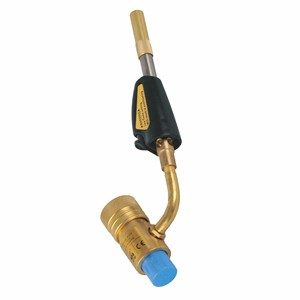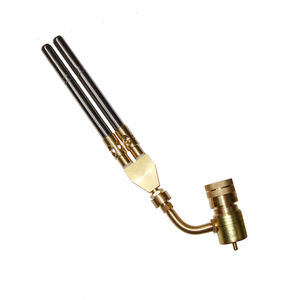(4703 products available)















































































































































































































A torch for soldering is a device used to solder metal pieces together. It consists of a gas cylinder, a soldering torch, and a soldering head. The gas cylinder contains the gas, which can be propylene, MAPP, or butane. The gas is transferred to the soldering torch through a hose pipe. The torch has a valve that controls the flow of gas. It also has a starter that ignites the gas to produce a flame. The flame is used to solder metal pieces together.
Soldering torches are commonly used in welding metal pieces together. They are also used to solder jewelry, electronics, and plumbing. They produce a high-temperature flame that can easily melt metals. Soldering torches come in different sizes and shapes. They also produce different flame temperatures and can be made from various materials. Here are some common types of soldering torches:
Handheld Soldering Torch
A handheld soldering torch is a simple device with a gas cylinder, a soldering torch, and a hose pipe. The gas cylinder stores the gas and transfers it to the soldering torch. The hose pipe connects the gas cylinder to the soldering head. Handheld torches for soldering are used in small-scale soldering tasks. They are mostly used in jewelry soldering, electronics, and plumbing. Handheld soldering torches are popular because they are easy to use and very portable.
Self-Igniting Soldering Torch
Self-igniting soldering torches have a built-in igniter. The igniter produces a spark that lights the gas, creating a flame. These soldering torches are very convenient because users don't have to use an external igniter to light the gas. They are commonly used in soldering tasks that require one to light the flame quickly.
Acetylene Soldering Torch
The acetylene welding torch uses oxygen and acetylene gases to create a flame. The torch has two gas cylinders. One gas cylinder contains oxygen, and the other one contains acetylene. The torch also has a pressure regulator. It controls the flow of gases into the soldering head and a welding hose pipe. The welding hose pipes transfer the gases to the soldering head. Acetylene torches for soldering are used in large-scale soldering tasks. They produce a high-temperature flame that can melt and solder thicker metals.
Soldering torches are simple devices. They have a few key features that are worth mentioning. These features can be used for everything from small electronics to large plumbing work.
Butane gas
The torch runs on butane gas. Butane is a clean-burning fuel. It produces little or no smoke. This makes torches safe to use. Butane is also very easy to store and transport. The torch comes with a gas canister. The canister is connected to the torch during use. When the gas reaches the torch, it is ignited. Butane gas torches are popular among hobbyists and professionals.
Adjustable flame
The adjustable flame feature allows users to customize the flame size and intensity. This makes the torch suitable for different types of work. The flame can be made smaller and more precise. This is useful for delicate soldering tasks. The flame can also be made bigger for larger solder joints. An adjustable flame helps to conserve fuel.
Piezo ignition
The torch can be lit using piezo ignition. This is a simple and safe way to light the torch. It doesn't need flint or a separate igniter. The piezo ignition system creates a spark when the torch is triggered. The spark lights the butane gas. The torch is ignited.
Refillable
The torch is refillable. This makes it more cost-effective and eco-friendly. When the gas runs out, it can be easily replaced. Refilling the torch reduces the need to buy new torches. This helps to reduce waste. Refilling also saves money over time.
Compact and lightweight
Soldering torches are known for their compact and lightweight design. This makes them very portable. They can easily be carried around in a toolbox or a backpack. The torch can be used in remote locations without access to power.
Locking flame feature
Some soldering torches have a locking flame feature. This allows users to lock the flame in place during extended use. The locking mechanism frees up one hand. It makes soldering tasks easier and more comfortable to complete. The feature also reduces hand fatigue during long soldering sessions.
Torches for soldering have a wide range of applications across various industries and fields. Here are some common usage scenarios:
Metalworking and Fabrication
Torch soldering is used for brazing, soldering, and welding of metals in workshops, jewelry making, and automotive repair.
Plumbing
It is used in the soldering of copper pipes and fittings to enable the installation and repair of water supply and heating systems.
Electronics
Torches are used in soldering components onto printed circuit boards (PCBs) in electrical devices for electronics manufacturing. They are also used for desoldering in electronics repair.
HVAC/R
They are used to solder and braze refrigerant lines in the installation and repair of heating, ventilation, air conditioning, and refrigeration systems.
Jewelry Making
Torch soldering is widely used in the jewelry industry for soldering metal components, setting gemstones, and annealing materials.
Glasswork
Torch soldering can be used for soldering metal came in stained glass projects and for glass blowing and lamp working.
Art and Craft
Artists and crafters use torch soldering techniques to join metals in various art projects, including sculptures and metal jewelry.
Repair and Maintenance
Soldering torches are commonly used for metal repairs in various applications such as machinery, tools, and equipment. They are also used to solder electrical connections and components.
Automotive
Torch soldering is used for brazing of metal components such as radiators, air conditioning lines, and exhaust systems. It is also used in the repair of automotive electrical connections and wiring.
Blacksmithing
In blacksmithing workshops, torch soldering can be used for tasks such as attaching handles to blades, creating hooks, and performing decorative metalwork.
Construction
It is used for the soldering of sheet metal in roofing, flashing, and gutters. It can also be applied in the soldering of metal fixtures and components during construction and maintenance activities.
When choosing the right soldering torch, keep in mind what type of work will be done. Some torches are better suited for certain kinds of jobs than others.
The size of the flame can also be important. A large flame may not be necessary for smaller jobs, but it can speed things up and make soldering more efficient on larger pieces. At the same time, a smaller flame is often all that is needed for intricate work.
Above, we mentioned that some torches work with one hand while others require two hands. A one-handed torch can help keep the other hand free to hold parts in place or manipulate the item being soldered. This can be a big advantage when working on detailed projects. However, two-handed torches often provide more stability and control.
How the flame is adjusted is something else to think about. Some torches have a dial that can be turned to change the size of the flame, while others have a lever. Dials tend to be more precise, but levers are faster. The way the flame is adjusted needs to be comfortable for the person using it.
Finally, take a good look at the safety features of the torch before purchasing it. Things like flame guards and automatic shut-offs can make a big difference in how safe the tool is to use. Be sure to pick a torch that has all the safety features necessary for the kinds of jobs that will be done.
Q1. Why is safety gear important when using a torch for soldering?
A1. Hot metals can cause serious injuries to the eyes and skin. Wearing safety gear protects workers from burns and eye damage.
Q2. What type of fuel is recommended for soldering torches?
A2. Propane and MAPP gas are popular choices. They provide a consistent flame that reaches high temperatures needed for soldering.
Q3. How can one maintain a soldering torch?
A3. Regular maintenance includes cleaning the nozzle and checking for leaks. This ensures the torch operates efficiently and safely.
Q4. Are there any alternatives to using a torch for soldering?
A4. Electric soldering tools can be used instead of torches. However, they may not reach the same high temperatures as a gas-powered tool.
Q5. What should be done if a torch starts leaking fuel?
A5. Leave the area immediately and follow emergency procedures. Never light a torch if it is leaking fuel. Contact a professional to fix the leak.